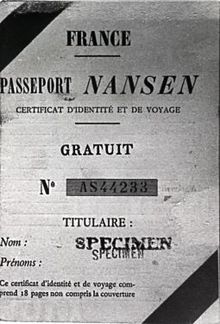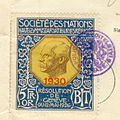- Nansen passport
-
Nansen passports were internationally recognized identity cards first issued by the League of Nations to stateless refugees.
Contents
Origins
Designed in 1921[1] by Fridtjof Nansen, in 1942 they were honored by governments in 52 countries and were the first refugee travel documents. Approximately 450,000 Nansen passports were issued, helping hundreds of thousands of stateless people to immigrate to a country that would have them.
The Nansen passport was developed as a result of a series of citizenship laws in European countries, including but not limited to the United Kingdom, Germany and France, that excluded millions of ethnic minorities, which were erstwhile residents in their countries, from attaining citizenship. Hundreds of thousands of them stayed permanently abroad.
Nobel Peace Prize
The Nansen International Office for Refugees was awarded the 1938 Nobel Peace Prize for its efforts to establish the Nansen passports.[2]
Today
While Nansen passports are no longer issued, present national authorities, including the United Nations, issue documents for stateless people and refugees. These include: Certificate of Identity (or "alien's passport"), the "Refugee Travel Document" and the United Nations laissez-passer.
References
- ^ Fridtjof Nansen, Indiana University Center for the Study of Global Change, 2006. Retrieved 22 February 2011.
- ^ Fridtjof Nansen, Nobelprize.org, 1922. Retrieved 22 February 2011.
External links
Passports (gallery) By continent AfricaAlgeria · Angola · Benin · Botswana · Burkina Faso · Burundi · Cameroon · Cape Verde · Central African Republic · Chad · Comoros · DR Congo · Rep. Congo · Côte d'Ivoire · Djibouti · Egypt · Equatorial Guinea · Eritrea · Ethiopia · Gabon · The Gambia · Ghana · Guinea · Guinea-Bissau · Kenya · Lesotho · Liberia · Libya · Madagascar · Malawi · Mali · Mauritania · Mauritius · Morocco (Western Sahara1) · Mozambique · Namibia · Niger · Nigeria · Rwanda · São Tomé and Príncipe · Senegal · Seychelles · Sierra Leone · Somalia (Somaliland1) · South Africa · South Sudan · Sudan · Swaziland · Tanzania · Togo · Tunisia · Uganda · Zambia · ZimbabweAsiaAfghanistan · Azerbaijan (Nagorno-Karabakh1) · Bahrain · Bangladesh · Bhutan · Brunei · Burma · Cambodia · People's Republic of China (Hong Kong · Macao) · Cyprus (Northern Cyprus1) · East Timor · Georgia (Abkhazia1 · South Ossetia1) · India · Indonesia · Iran · Iraq · Israel (Palestine1) · Japan · Jordan · Kazakhstan · Kuwait · North Korea · South Korea · Kyrgyzstan · Laos · Lebanon · Malaysia · Maldives · Mongolia · Nepal · Oman · Pakistan · Philippines · Qatar · Saudi Arabia · Singapore · Sri Lanka · Syria · Republic of China (Taiwan)1 · Tajikistan · Thailand · Turkey · Turkmenistan · United Arab Emirates · Uzbekistan · Vietnam · YemenEuropeAlbania · Andorra · Armenia · Austria · Belarus · Belgium · Bosnia and Herzegovina · Bulgaria · Croatia · Czech Republic · Denmark · Estonia · Finland · France · Germany · Greece · Hungary · Iceland · Ireland · Italy (SMO of Malta1) · Latvia · Liechtenstein · Lithuania · Luxembourg · Macedonia · Malta · Moldova (Transnistria1) · Monaco · Montenegro · Netherlands · Norway · Poland · Portugal · Romania · Russia · San Marino · Serbia (Kosovo1) · Slovakia · Slovenia · Spain · Sweden · Switzerland · Ukraine · United Kingdom (Anguilla · Bermuda · BN(O) · British Virgin Islands · Cayman Islands · Falkland Islands · Gibraltar · Guernsey · Jersey · Isle of Man · Montserrat · Pitcairn Islands · Saint Helena · Turks and Caicos Islands) · Vatican CityNorth AmericaAntigua and Barbuda · Bahamas · Barbados · Belize · Canada · Costa Rica · Cuba · Dominica · Dominican Republic · El Salvador · Grenada · Guatemala · Haiti · Honduras · Jamaica · Mexico · Nicaragua · Panama · Saint Kitts and Nevis · Saint Lucia · Saint Vincent and the Grenadines · Trinidad and Tobago · United States (Iroquois League1)OceaniaAustralia · Fiji · Kiribati · Marshall Islands · Federated States of Micronesia · Nauru · New Zealand · Palau · Papua New Guinea · Samoa · Solomon Islands · Tonga · Tuvalu · VanuatuSouth AmericaCommon-designs Andean Community of Nations · Caribbean Community · Central America-4 · Economic and Monetary Community of Central Africa · Economic Community of West African States · European Union (Laissez-Passer) · MercosurInternational
organizationsBy type Defunct British Indian Empire · British Mandate for Palestine · Czechoslovakia · East Germany · League of Nations refugee · Soviet Union · UNMIK Travel Document · YugoslaviaOther Notes 1 Unclassified by the United Nations geoscheme due to its non-membership in the UN. It is listed following the member state the UN categorises it under.
This passport-related article is a stub. You can help Wikipedia by expanding it.



